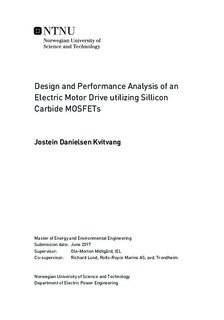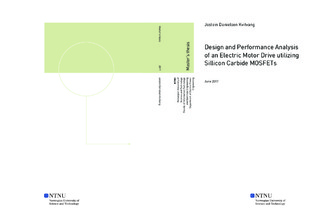| dc.description.abstract | The recent commercialization SiC technology, has made it desirable to use SiC in electrical motor drives for marine applications, due to the superior material qualities of SiC compared to conventional Si based technology. This Master thesis will present an analysis of the switching performance of a SiC MOSFET module from ROHM Semiconductor, and an accompanying investigation of how a high performance SiC based motor drive can be realized.
As part of the thesis work, the many critical components of an electrical motor drive system was investigated, and this will be described in this thesis. Two printed circuit boards were produced to enable the SiC modules to be operated using a motor controller. In addition, a low inductive three phase DC-bus was designed, produced and tested.
The three phase DC-bus design will be described through theoretical considerations, before an experimental analysis of the stray inductance of the DC-bus is presented. It will be shown that a low inductive design can be realized through the use of planar copper conductors, and the DC-bus design has good inductive capabilities compared with a single half-bridge DC-bus which was used in the experimental SiC characterization.
The SiC module performance characterization was conducted by performing double-pulse testing, both in simulations and in laboratory experiment. It was shown that the presence of stray inductive elements in the circuit causes voltage overshoots up to 110 V over the nominal voltage of 600 V and long lasting ringing. The switching characteristics calculated from these tests will be presented, and the circuit dynamics giving rise to these effects discussed. A comparison between the simulation results and experimental results was made, and it will be shown that while the simulation model captures some switching characteristics well, it fails to model the large voltage overshoots observed in laboratory experiments.
Further more, it was investigated if switching performance could be improved through the introduction of snubber circuits, in particular RC turn-off snubbers and DC-snubbers. Both the simulation results and the experimental results showed that the RC turn-off snubbers failed to remove the overvoltages completely, but was able to reduce it to 35 V with a snubber damping constant of 0.4. This comes at the cost of increased switching losses however, and it is clear that a trade off must be made. | |

